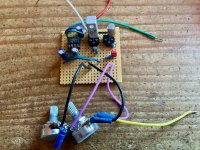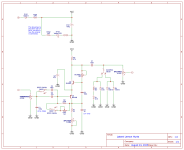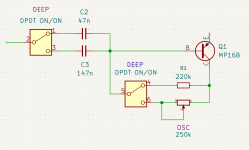You are using an out of date browser. It may not display this or other websites correctly.
You should upgrade or use an alternative browser.
You should upgrade or use an alternative browser.
What to make with 30-50 hFE Germaniums
- Thread starter rossbalch
- Start date
Feral Feline
Well-known member
Sure, but you'd need at least 124-bit encryption to thwart the reverse-engineering tracers...Could you not cascode them?
124 bit… shocking! (I used to sell optical quantum cryptography before we got down that rabbit hole).Sure, but you'd need at least 124-bit encryption to thwart the reverse-engineering tracers...
Could be fun, any sweet example circuits?Could you not cascode them?
I probably have like 100 devices in this range, so I could make quite a few things ha ha. Would really love to do a microphone preamp, and line amp too.
Could be fun, any sweet example circuits?
I probably have like 100 devices in this range, so I could make quite a few things ha ha. Would really love to do a microphone preamp, and line amp too.
A cascode is a great way to increase gain, but it has lousy PSRR and a high output impedance. Often you’ll see a cascode followed by a cathode follower. This means you get increased gain and then a driver to stop the next stage/pedal from seeing a high impedance. Furthermore, you’ll want a stopper resistor on the input as it may pickup RF due to the same increased bandwidth.
What that means is your los hfe can be used to get more gain.
I don’t have a specific circuit but a fuzz or distortion can be built using it. If there’s too much gain you could use some NFB or even abuse that for nee tones.
A cascode is a great way to increase gain, but it has lousy PSRR and a high output impedance. Often you’ll see a cascode followed by a cathode follower. This means you get increased gain and then a driver to stop the next stage/pedal from seeing a high impedance. Futhermor, you’ll want a stopper resistor on the input as it may pickup R lF due tothe same increased bandwidth.
What that means is your los hfe can be used to get more gain.
I don’t have a specific circuit but a fuzz or distortion can be built using it. If there’s too much gain you could use some NFB or even abuse that for nee tones.
Yeah there's no reason the design needs to be all Germanium, would be fine to use a JFET input buffer for instance, and a Si BJT follower to buffer the output.
mybud
Well-known member

I breadboarded this Zonk II (following some experimentation with values, eventually settling on the Amplified Parts version: details here.)
I like it so much that I built a Vero version, as above.
This seems much more forgiving than the Zonkbox and gives a nice creamy sustain and lots of volume on tap.
Used the following configuration:
Q1 AC128 (hFE 80, leakage 0.243mA)
Q2 OC75 (hFE 97, leakage 0.294mA)
Also added a charge pump because this seems to help the circuit stabilise (more than straightforwardly reversing the voltage and electrolytics) and for compatibility with a centre negative setup as most pedals need. I prefer C1k for B1k for the fuzz control, obviously a matter of taste.
Is this entirely relevant to OP's question about low gain Germaniums?
No, but the circuit's fun anyway
Thanks for reading as ever and best of luck with your projects.
Synchrony Pedalworks
Well-known member
Thanks for posting. I have this circuit in my table. You notes will help me select some good transistors.View attachment 100307
I breadboarded this Zonk II (following some experimentation with values, eventually settling on the Amplified Parts version: details here.)
I like it so much that I built a Vero version, as above.
This seems much more forgiving than the Zonkbox and gives a nice creamy sustain and lots of volume on tap.
Used the following configuration:
Q1 AC128 (hFE 80, leakage 0.243mA)
Q2 OC75 (hFE 97, leakage 0.294mA)
Also added a charge pump because this seems to help the circuit stabilise (more than straightforwardly reversing the voltage and electrolytics) and for compatibility with a centre negative setup as most pedals need. I prefer C1k for B1k for the fuzz control, obviously a matter of taste.
Is this entirely relevant to OP's question about low gain Germaniums?
No, but the circuit's fun anyway
Thanks for reading as ever and best of luck with your projects.
mybud
Well-known member
Only a pleasure. I think you will enjoy the sound if you’re into vintage fuzz, from dark at minimum to somewhat raspy at full bore. Also cleans up nicely with guitar volumeThanks for posting. I have this circuit in my table. You notes will help me select some good transistors.
pettert
Clipping Connoisseur
Build the Latent Lemon variety of Harmonic Percolator. It's best with transistors that has hfe in the 40-50 range.
DirtboxLayouts posted a veroboard layout of the schematic above about a week ago
It's a really cool take on the Harmonic Percolator. I traced it from some photos, which isn't generally the best practice, but what I have on the breadboard sounds right on to my ears. Anyway, it's a simple but fun dirt circuit. Here's the schematic:

Some notes:

Some notes:
- For Q1, any low leakage germanium with an hFE between 30 and 70 works well, with best results between 40 and 60. Below 30 is too dark/sputtery, above 70 is too bright/smooth, but that's my personal preferences—go on and experiment yourself!
- For Q2, shoot for something in the 225-275 range. Tayda's 2N3904...
- PedalBuilder
- Replies: 0
- Forum: Community Boardroom
DirtboxLayouts posted a veroboard layout of the schematic above about a week ago
PedalBuilder
Well-known member
I agree that a Percolator is a good use for low hFE germanium transistors, but I am not a huge fan of that layout. The 3362 single turn trimmers that are used in that layout don't give you sufficiently granular control over the octave or oscillation. If you do build it, I recommend adjusting the layout to use 3296 multi-turn trimmers.Build the Latent Lemon variety of Harmonic Percolator. It's best with transistors that has hfe in the 40-50 range.
It's a really cool take on the Harmonic Percolator. I traced it from some photos, which isn't generally the best practice, but what I have on the breadboard sounds right on to my ears. Anyway, it's a simple but fun dirt circuit. Here's the schematic:

Some notes:
- For Q1, any low leakage germanium with an hFE between 30 and 70 works well, with best results between 40 and 60. Below 30 is too dark/sputtery, above 70 is too bright/smooth, but that's my personal preferences—go on and experiment yourself!
- For Q2, shoot for something in the 225-275 range. Tayda's 2N3904...
- PedalBuilder
- Replies: 0
- Forum: Community Boardroom
DirtboxLayouts posted a veroboard layout of the schematic above about a week ago
pettert
Clipping Connoisseur
I agree that a Percolator is a good use for low hFE germanium transistors, but I am not a huge fan of that layout. The 3362 single turn trimmers that are used in that layout don't give you sufficiently granular control over the octave or oscillation. If you do build it, I recommend adjusting the layout to use 3296 multi-turn trimmers.
Like this perhaps?

Last edited:
PedalBuilder
Well-known member
Sure, but you shouldn’t need to change the Deep switch configuration if the only thing that you want to do is change the type of trimmer.
pettert
Clipping Connoisseur
True, I misunderstood and at the same time had been thinking about wanting to change that switch.Sure, but you shouldn’t need to change the Deep switch configuration if the only thing that you want to do is change the type of trimmer.
Ginsly
Well-known member
Out of curiosity, why change that switch from the way @PedalBuilder had it?True, I misunderstood and at the same time had been thinking about wanting to change that switch.
pettert
Clipping Connoisseur
I just think it looks a bit nicer, to be honest. 220kΩ in parallell with 1MΩ is 177kΩ.ΩOut of curiosity, why change that switch from the way @PedalBuilder had it?
I think the value you tune in to stop the oscillation is always quite a bit below that though, but with "my" way you don't get that gap between 220kΩ and 177kΩ.
